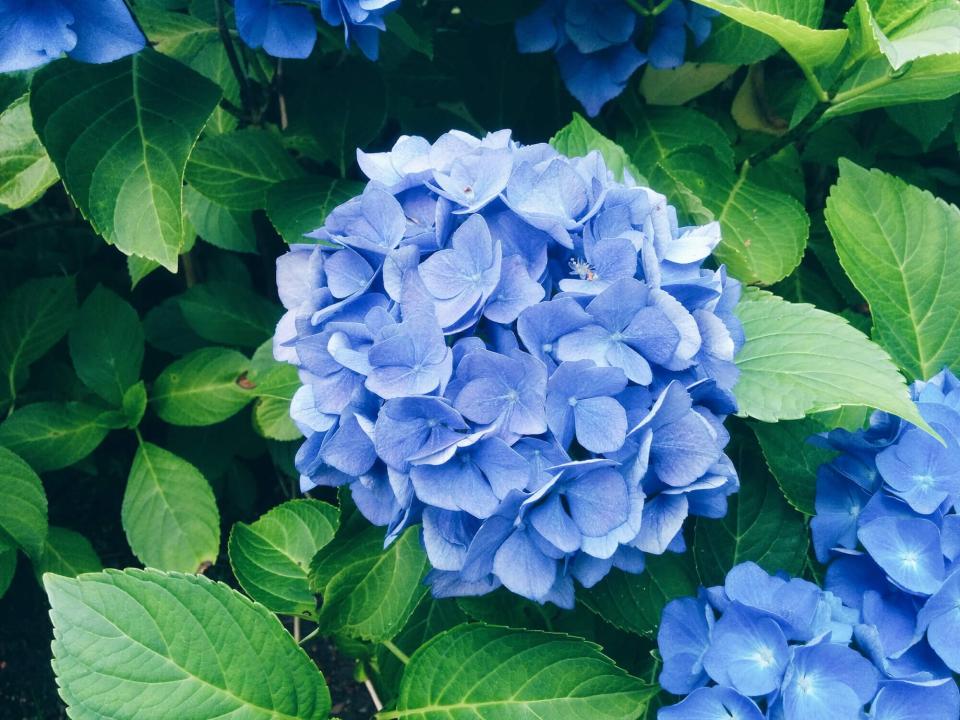If You Want the Boldest Blue Hydrangeas, the Secret is in Your Coffee Grounds

Getty Images
French hydrangeas are prized for their globe-like blooms, popping off like fireworks shows in gardens throughout the late spring and early summer. Mopheads are typically pink, blue, or white, but can also be manipulated to suit color preferences–if you're willing to get your hands dirty.
What color blooms your hydrangeas will deliver is dependent on the pH-level of the soil in which it's planted. The higher the acidity (pH less than six), the bluer your blooms, while more alkaline soil (pH greater than seven) typically results in pinkish flowers. There are certain hydrangea names that might lead you to believe they're a sure thing as far as color goes (Nikko Blue and Nantucket Blue, for example), but even they are at the whim of their soil's pH level.
Video: This pantry item can help keep cut hydrangeas fresh
In order to guarantee blue blooms, you'll have to ensure your soil falls into the acid category. There are fertilizers that can help you on that quest, but other household ingredients can prove just as effective–and come with a lower cost. Enter, your leftover coffee grounds. Here's everything you need to know about how to produce the bluest hydrangea blooms while putting those spent coffee grounds to good use.
Which Hydrangea Varieties Can Produce Blue Flowers?
Step one in achieving your blue hydrangea goals is selecting a variety that can produce blue flowers. Oakleaf hydrangeas (Hydrangea quercifolia), Annabelle hydrangeas (Hydrangea arborescens), and Peegee (Hydrangea paniculata 'Grandiflora') are all white/ivory bloomers and won't change shades no matter the soil pH levels. If you have French hydrangeas or lacecaps (Hydrangea macrophylla normalis) though, it's game on.
How To Test Soil pH
If you haven't already seen your hydrangeas through a bloom season, you can test your soil pH level with a store-bought kit from your local hardware or garden-supply store. You can also go the DIY route with this nifty trick:
Start by gathering two plastic containers, vinegar, and baking soda. Place a few scoops of dirt into each container using a hand trowel; then moisten both batches of dirt with a half cup water. Pour half a cup of vinegar in one bowl of soil. If it fizzes, your soil is alkaline. Add a half cup of baking soda to the second container. If that mixture results in some fizzing or bubbling, then your soil is acidic.
So, what if you come up with no reaction for either mixture? You didn't necessarily mess up the experiment, it just means your soil is neutral. If your bubbling or fizzing mixture produced a small reaction, your soil sample skews more toward the neutral end of the alkaline or acidic spectrum.
Keep in mind, if your soil is already acidic, you should be set for some blue blooms–even without an acid-boosting mix-in like coffee grounds. Hooray!
How To Change Hydrangea Color with Coffee Grounds
Start adding coffee grounds to the soil surrounding your hydrangeas in late fall. Sprinkle them around your hydrangeas, but be sure to work them into the soil to help eliminate any off-putting smell. You do not need to do this process often–just two to three times per year should be sufficient.
How Long Will It Take To Turn Hydrangeas Blue?
Pouring your leftover morning coffee grinds on your hydrangea soil won't result in blue blooms by mid-afternoon. It's going to take some time–even more so if you have brand new baby hydrangeas that might not bloom for a couple years yet. It's best to start adding coffee grounds to the soil months before the blooming season begins, ideally in the late fall. You can repeat the process with your typical fertilizing schedule.
With a little caffeine and a lot of patience, your hydrangeas should reward your efforts come spring with the boldest blue globes. Just be prepared to share your secret ingredient with the neighborhood—they'll be green with envy at first bloom.

